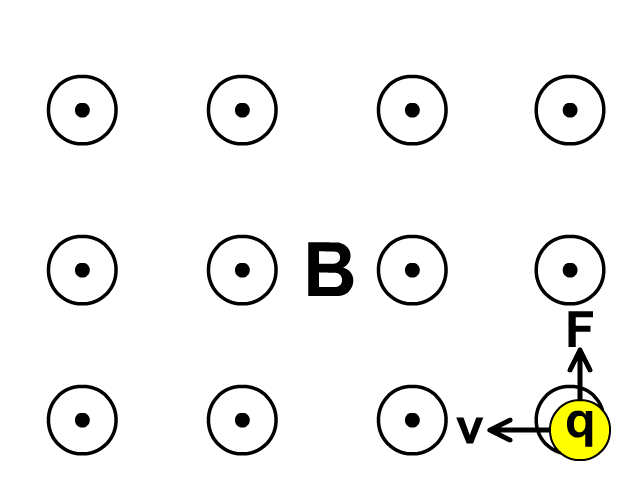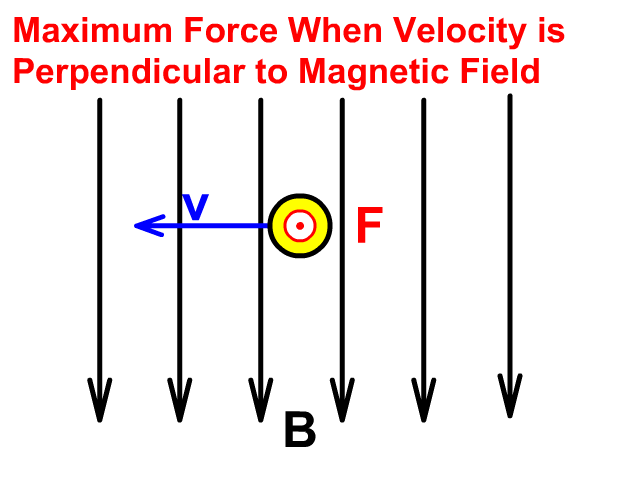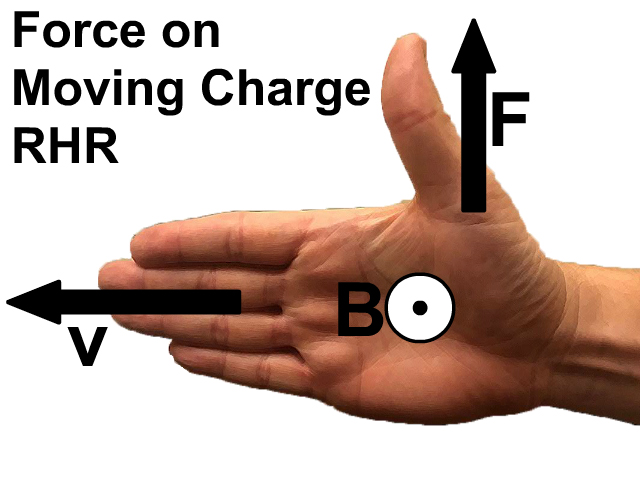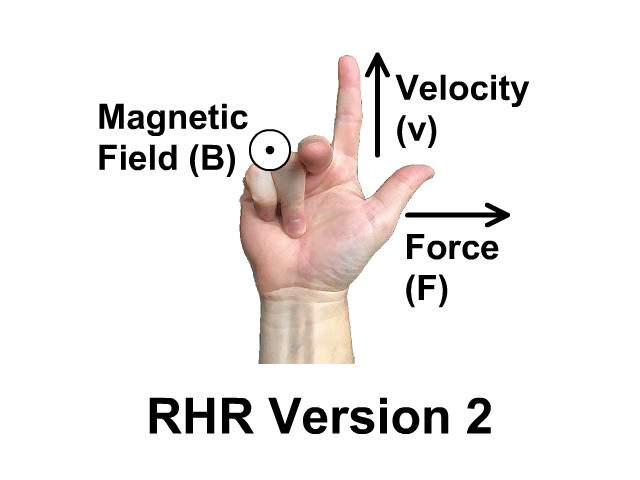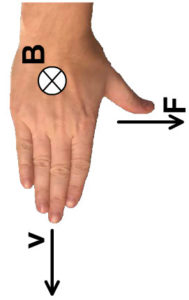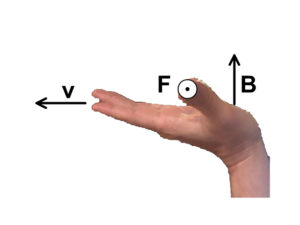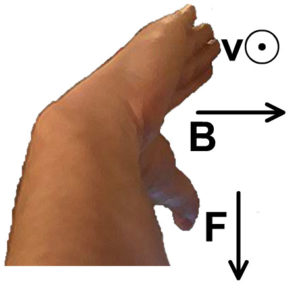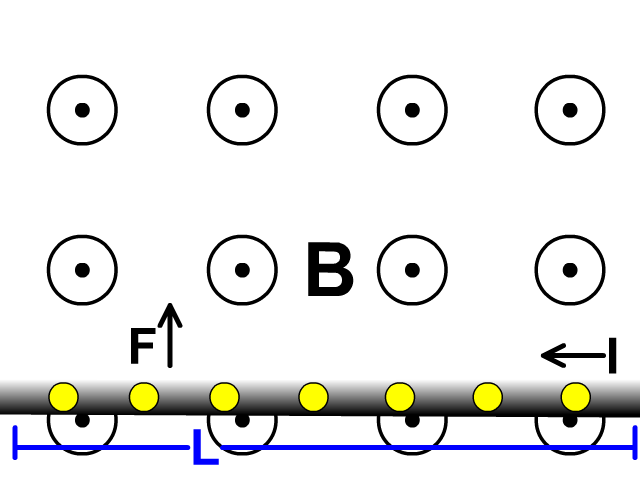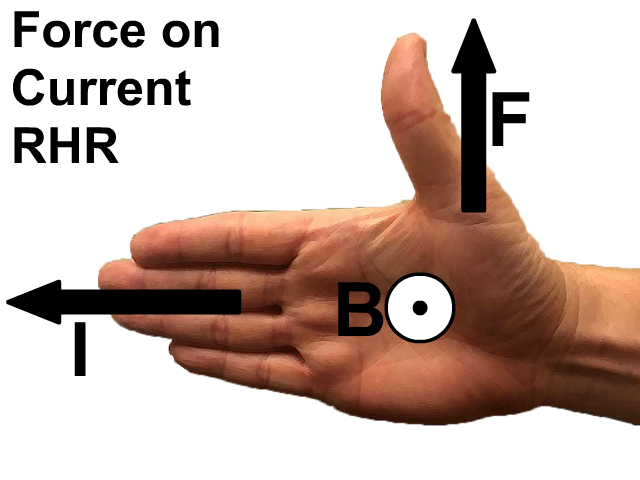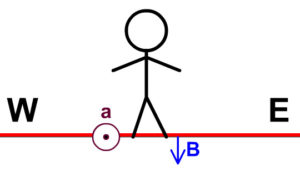Force on a Moving Charge
A force on a moving charge is maximum when created by a magnetic field perpendicular to the moving charge. Learn to calculate force and determine direction.
Variables Used in this Force on a Moving Charge Page
| Variable | MKS Unit | Unit Abbreviation | |
| Charge | q | Coulomb | C |
| Current | I | Ampere | A |
| Force | F | Newton | N |
| Length | L | Meter | m |
| Magnetic Field | B | Tesla | T |
| Velocity | v | Meters per second | m/s |
Force on Charge Moving in a Magnetic Field
A force (F) on a moving charge (q) will be maximum at a velocity (v), perpendicular to Magnetic Field (B).
Force will be less with velocity at any angle less than perpendicular to the magnetic field and no force is present when velocity is parallel.
The amount of the force relates to the size of magnetic field, the magnitude of charge, and the velocity it is moving.
This equation represents the relationship:
F = Bqv
force = (magnetic field)(charge)(velocity)
Observe in the animation that the screen has a magnetic field towards you (circle with a dot represents towards you). The particle moving left creates a force up. The direction of force causing acceleration changes as velocity changes curving upward in this field.
Maximum Force When Velocity or Current is Perpendicular
On this page, we will stick to simple mathematical problems with charge traveling perpendicular to a magnetic field.
A charge or current moving parallel to the magnetic field would have no force. Any velocity between perpendicular and parallel would only have the perpendicular component used in the solution for force.
Moving Positive Charge in a Magnetic Field Right Hand Rule (RHR)
When determining the direction of force, velocity, or magnetic field for a positive charge you can use a right hand rule mnemonic. This may be used in conjunction with F=Bqv equation to determine direction of a variable.
(Version 1)
When holding your hand open with your thumb up at a right angle to your fingers:
- Force: the direction of your thumb
- Magnetic Field: the direction your palm is facing
- Velocity: the direction of your fingers for the positive charge
(Version 2) of the Same Positive Moving Charge in a Magnetic Field RHR
Depending on your teacher they may have taught you an alternate version of the previous right hand rule. Both show the exact same relationship between magnetic field, force, and velocity.
- Force: the direction of your thumb
- Velocity: the direction of your pointer finger
- Magnetic Field: the direction of your middle finger
Exception to the RHR for a Negative Charge
Some questions will have an electron or negative charge moving in a magnetic field. If you see this in a problem, use your left hand instead of your right. So when using the left hand of version 1 of the right hand rule for charge moving in a magnetic field:
- Force: the "left hand" thumb
- Magnetic Field: "left hand" palm
- Velocity: "left hand" fingers will represent the velocity of the negative charge.
Example Problems
1. What direction is a positive charge moving if force is going to the right and the magnetic field is directed away from you into the page?
2. What direction is force, if a negative charge is moving in a magnetic field directed upwards to the top of the page and the velocity is left?
3. What direction is the magnetic field if a proton has a velocity is into the page away from you and force is directed down the page?
4. Would a particle have a positive or negative charge if force is directed down the page when the particle was moving out of the page towards you in a magnetic field to the right?
5. What is the magnitude of force when a 2.51 C charge is traveling 422 m/s perpendicular to a magnetic field of 2.20 T?
6. A charge of +3.2 x10-6 C is traveling at north at 450 m/s in a magnetic field to the east. The magnetic force it experiences is 4.25 x 10-3 N. What is the strength of the magnetic field and direction of the force?
Force on Wire Carrying Current in a Magnetic Field
A moving charge can be represented by a current (I) in a length of wire (L) perpendicular to a magnetic field. This would also have a maximum force (F) when perpendicular to a magnetic field magnetic field (B).
This equation represents the relationship:
F = BIL
force = (magnetic field)(current)(length of wire)
Force on a Wire Carrying Current in a Magnetic Field RHR
Conventional current involves a positive flow of charge so this right hand rule is very similar to the right hand rule for a moving positive charge.
Here you replace the fingers representing which was velocity before for current. This right hand rule would be used in conjunction with F = BIL to determine the direction of one of the variables.
When holding your hand open with your thumb up at a right angle to your fingers:
- Force: the direction of your thumb
- Magnetic Field: the direction your palm is facing
- Current: the direction of your fingers
Example Problems
7. A current carrying wire lies horizontally in front of you west to east on the ground. If the magnetic field is directed into the ground and the wire accelerates toward you, in which direction is the current flowing? (Note: Force causes acceleration so the force in the wire is towards you)
8. An engineer want to place a wire in a magnetic field facing north so that it helps support itself in the air when current is flowing. What direction should current run in this wire? (east to west, west to east, north to south, or south to north?
9. What is the magnitude of force in 10.0 meter wire with 5.00 amps of current traveling perpendicular to a 2.10 T magnetic field?
10. How much current would be traveling perpendicular to a 1.70 T magnetic field when a force of 50.0 N is present in an 80.0 meter wire?
Links
- On to Magnetic Induction
- Back to the Main Magnets and Magnetism Page
- Back to the Stickman Physics Home Page
- For video tutorials and other physics resources check out HoldensClass.com
- Find many of your animation resources in one place at the StickMan Physics Gallery
- Equation Sheet

